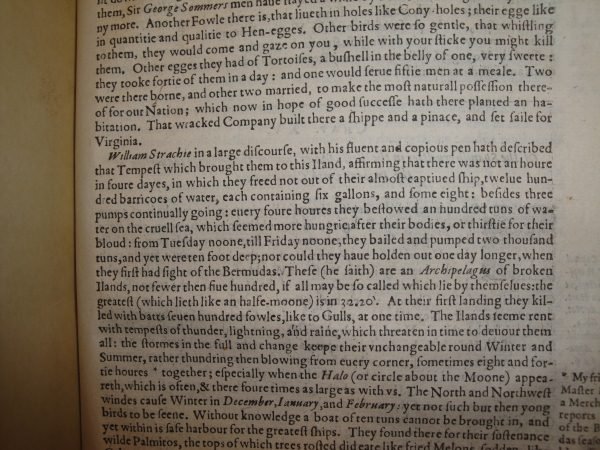William Shakespeare was 50 years old in 1614. He was now married, had three children, and had lost his son Hamnet who died aged 11. He had been living and working in London, had written the majority of his plays, and bought New Place, the largest residential home in Stratford.

The Tempest was written a few years earlier and was first performed in 1611. There is an account of a shipwreck which is thought to have inspired the play which appears in print in the 1614 edition of Purchas His Pilgrimage by Samuel Purchas. Purchas His Pilgrimage is a compilation of travel literature describing Asia, Africa, and America, drawn from Spanish, French, German, and English sources, which Purchas collected and edited. A later edition of the book contains William Strachey’s ‘A True Reportory’, but the 1614 edition contains references to the conversations Purchas had with Strachey. In 1609, Strachey was aboard the Sea Venture when a hurricane hit it and the Virginia-bound fleet. Strachey wrote a letter about the crew’s ordeal and their nine-month stay on the island of Bermuda.

The account was brought back to England and circulated by Thomas Gates, another member of the Sea Venture’s unfortunate crew, in early September, 1610. It is assumed that Shakespeare read it the same year, having been granted access to the letter by his patron, the earl of Southampton, who was a member of the Virginia Company. Strachey’s narrative provided inspiration for Shakespeare: a violent storm; the seemingly miraculous survival of the crew; attempted mutinies; and the almost magical rejuvenation of men marooned on an enchanted and fruitful island.

‘William Strachey in a large discourse … hath described the Tempest which brought them to this island’ (Purchas 1614, 911).
1614 was also a year of crisis and controversy in Stratford. In July there was a great fire in the town which swept through the thatched buildings; it was the third in living memory. 54 dwellings burned to the ground as well as stables and barns which were full of grain and hay. A collection was taken up for the victims. The other big talking point of the year was the issue of enclosure, a storm of which William Shakespeare was at the centre. Arthur Mainwaring, steward to Lord Chancellor Ellesmere, was promoting a scheme to enclose the common fields of Welcombe. Shakespeare already owned a share in the Stratford tithes and as such was at the head of the list of ‘Ancient freeholders in the fields of Oldstratford and Welcombe’ which the Town Clerk, Thomas Greene, drew up on 5th September in response to the proposed scheme.

Enclosure meant consolidating the yardlands – these were bundles of acre or half-acre strips in an open field – into larger units bounded by fences or hedges. If the Welcombe fields were enclosed then the arable tracts would be converted into sheep pasture-land, which yielded less income per square acre than grain and hay. Property holders were concerned by enclosure as it reduced employment and forced up the price of grain. We have pages from the diary of Thomas Greene from 1614. Greene looked after the minutes of corporation meetings in the Gild Hall, and also participated in council deliberations. In his diary, he refers to Shakespeare as “cousin,” and there are four references to William Shakespeare’s involvement in the Welcombe enclosures between 1614 and 1615 (BRU15/13/26a-29). The mere suggestion of enclosure made Greene extremely nervous. At a meeting on 23rd September, he voiced his anxieties in the council, which voted unanimously to oppose enclosure. Meanwhile, Shakespeare prudently entered into a covenant with Mainwaring’s cousin, William Replingham, who was acting as Mainwaring’s legal agent. Replingham undertook to compensate William Shakespeare, or his heirs or assigns, ‘for all such loss, detriment and hindrance’ with respect to the annual value of his tithes. We also have the Replingham Agreement in our collection. The enclosure process continued for another few years, concluding two years after Shakespeare’s death.

One item from our museum collection from the time is a Gentleman’s night cap which dates to around 1610 (STRST : SBT 1994-70). Shakespeare may have worn a night cap like this towards the end of his life. The night cap is made of linen and is embroidered with coloured silks. It was cut from a single piece of linen with four shaped quarters and a turned up brim; each quarter contains a composite plant of rose, borage, pansy and strawberry enclosed within a coiling stem; small scale versions of the same plant decorate the brim.
All images are copyright © Shakespeare Birthplace Trust unless otherwise stated
With thanks to Philip Tromans for information on Purchas His Pilgrimage and Catherine Simpson for information on the night cap.
Other sources used:
Bearman, R. (1994). Shakespeare in the Stratford Records, Stroud: Alan Sutton Publishing Ltd.
Schoenbaum, S. (1977). William Shakespeare A Compact Documentary Life, Oxford: Clarendon Press.
